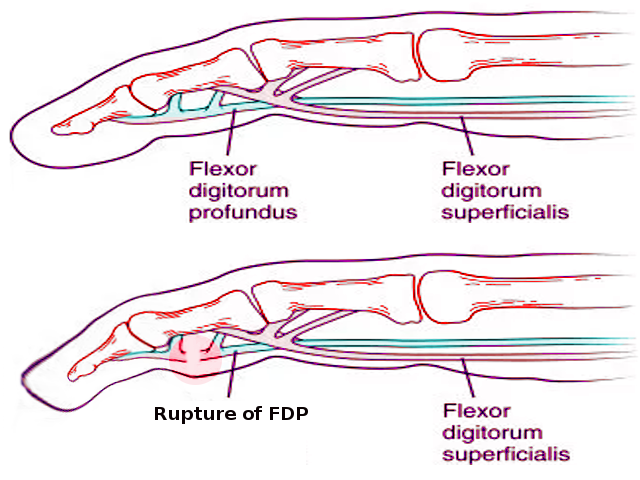[1]
Lunn PG, Lamb DW. "Rugby finger"--avulsion of profundus of ring finger. Journal of hand surgery (Edinburgh, Scotland). 1984 Feb:9(1):69-71
[PubMed PMID: 6707505]
[2]
Folmar RC, Nelson CL, Phalen GS. Ruptures of the flexor tendons in hands of non-rheumatoid patients. The Journal of bone and joint surgery. American volume. 1972 Apr:54(3):579-84
[PubMed PMID: 5055155]
[3]
Bachoura A, Ferikes AJ, Lubahn JD. A review of mallet finger and jersey finger injuries in the athlete. Current reviews in musculoskeletal medicine. 2017 Mar:10(1):1-9. doi: 10.1007/s12178-017-9395-6. Epub
[PubMed PMID: 28188545]
[4]
Yeh PC, Shin SS. Tendon ruptures: mallet, flexor digitorum profundus. Hand clinics. 2012 Aug:28(3):425-30, xi. doi: 10.1016/j.hcl.2012.05.040. Epub 2012 Jul 3
[PubMed PMID: 22883898]
[5]
Ootes D, Lambers KT, Ring DC. The epidemiology of upper extremity injuries presenting to the emergency department in the United States. Hand (New York, N.Y.). 2012 Mar:7(1):18-22. doi: 10.1007/s11552-011-9383-z. Epub 2011 Dec 14
[PubMed PMID: 23449400]
[6]
de Jong JP, Nguyen JT, Sonnema AJ, Nguyen EC, Amadio PC, Moran SL. The incidence of acute traumatic tendon injuries in the hand and wrist: a 10-year population-based study. Clinics in orthopedic surgery. 2014 Jun:6(2):196-202. doi: 10.4055/cios.2014.6.2.196. Epub 2014 May 16
[PubMed PMID: 24900902]
[7]
BOYES JH, WILSON JN, SMITH JW. Flexor-tendon ruptures in the forearm and hand. The Journal of bone and joint surgery. American volume. 1960 Jun:42-A():637-46
[PubMed PMID: 13849148]
[8]
Manske PR, Lesker PA. Avulsion of the ring finger flexor digitorum profundus tendon: an experimental study. The Hand. 1978 Feb:10(1):52-5
[PubMed PMID: 710982]
[9]
Leddy JP, Packer JW. Avulsion of the profundus tendon insertion in athletes. The Journal of hand surgery. 1977 Jan:2(1):66-9
[PubMed PMID: 839056]
[10]
Klauser A, Frauscher F, Bodner G, Halpern EJ, Schocke MF, Springer P, Gabl M, Judmaier W, zur Nedden D. Finger pulley injuries in extreme rock climbers: depiction with dynamic US. Radiology. 2002 Mar:222(3):755-61
[PubMed PMID: 11867797]
[11]
Zemirline A, Asmar G, Liverneaux PA. Conservative treatment in Jersey finger: a case report. Journal of plastic, reconstructive & aesthetic surgery : JPRAS. 2013 Nov:66(11):1616-8. doi: 10.1016/j.bjps.2013.03.026. Epub 2013 Apr 19
[PubMed PMID: 23602271]
Level 3 (low-level) evidence
[12]
Pappas N, Gay AN, Major N, Bozentka D. Case report: pseudotendon formation after a type III flexor digitorum profundus avulsion. Clinical orthopaedics and related research. 2011 Aug:469(8):2385-8. doi: 10.1007/s11999-011-1906-y. Epub 2011 May 3
[PubMed PMID: 21538197]
Level 3 (low-level) evidence
[13]
Polfer EM, Sabino JM, Katz RD. Zone I Flexor Digitorum Profundus Repair: A Surgical Technique. The Journal of hand surgery. 2019 Feb:44(2):164.e1-164.e5. doi: 10.1016/j.jhsa.2018.08.015. Epub 2018 Oct 8
[PubMed PMID: 30309664]
[14]
Halát G, Negrin LL, Unger E, Koch T, Streicher J, Erhart J, Platzer P, Hajdu S. Introduction of a new repair technique in bony avulsion of the FDP tendon: A biomechanical study. Scientific reports. 2018 Jul 2:8(1):9906. doi: 10.1038/s41598-018-28250-y. Epub 2018 Jul 2
[PubMed PMID: 29967345]
[15]
Tuttle HG, Olvey SP, Stern PJ. Tendon avulsion injuries of the distal phalanx. Clinical orthopaedics and related research. 2006 Apr:445():157-68
[PubMed PMID: 16601414]
[16]
Becker H. Primary repair of flexor tendons in the hand without immobilisation-preliminary report. The Hand. 1978 Feb:10(1):37-47
[PubMed PMID: 101426]
[17]
Becker H, Orak F, Duponselle E. Early active motion following a beveled technique of flexor tendon repair: report on fifty cases. The Journal of hand surgery. 1979 Sep:4(5):454-60
[PubMed PMID: 387859]
Level 3 (low-level) evidence
[18]
Gillig JD, Smith MD, Hutton WC, Jarrett CD. The effect of flexor digitorum profundus tendon shortening on jersey finger surgical repair: a cadaveric biomechanical study. The Journal of hand surgery, European volume. 2015 Sep:40(7):729-34. doi: 10.1177/1753193415585311. Epub 2015 May 12
[PubMed PMID: 25969412]
[19]
McCallister WV, Ambrose HC, Katolik LI, Trumble TE. Comparison of pullout button versus suture anchor for zone I flexor tendon repair. The Journal of hand surgery. 2006 Feb:31(2):246-51
[PubMed PMID: 16473686]

